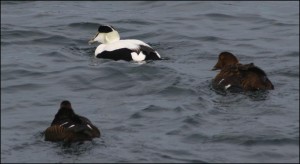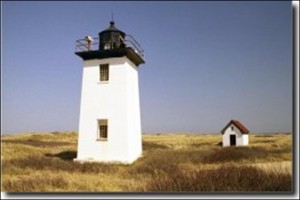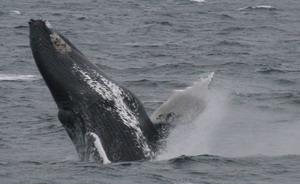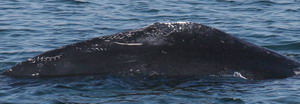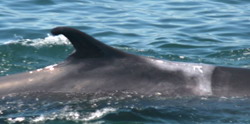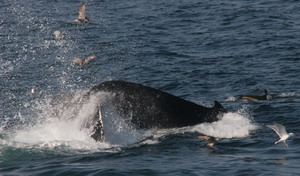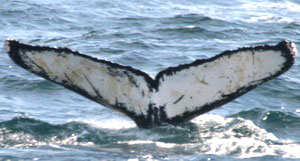DOLPHIN FLEET NATURALIST NOTEBOOK 26 APRIL TO 2 MAY 2008
DOLPHIN FLEET NATURALIST NOTEBOOK 26 APRIL TO 2 MAY 2008
Saturday 26 April
Another bright, beautiful day as the DVIII leaves for the morning whale watch. This morning the harbor is filled with eider ducks, a common, year-round site in Provincetown. Eider ducks spend almost all of their lives on or in the water. They feed primarily during the day, and at low tide, avoiding strong winds and large waves in Provincetown’s protected harbor. They dive well below the surface and use their wings to swim under water feeding on crabs, snails, mussels, clams, starfish, sea urchins and other small marine life. The common eider male’s color pattern is the reverse of most aquatic birds – with black bellies and white backs. The females are mottled brown, well camouflaged against their seaweed nesting habitat.
Eider ducks
It is not long before we sight our first whale, a small humpback that has been in the harbor for the past week. It is thought that the juveniles might winter in near-shore waters and not migrate to the breeding grounds in the Caribbean Sea. Another small humpback is sighted near Long Point, but we slowly make our way into Cape Cod Bay. Far to the west our spotter has found several whales. As we approach the area we begin to see the spouts of finback and humpback whales and the splashes of Atlantic white-sided dolphins. Although there are several whales we cannot identify, we record and photograph Putter, Springboard, Pepper, Quad, Thumper, Flounder, Ganesh, Rune and her calf of 2007, Glo and Reflection.
Putter
By afternoon and early evening the whales are a bit further to the North but still within the Bay. Some have moved to the rich waters of the Race Point rip. The numbers of whales continue to amaze us, as we busily record their behavior, location, and associations. Most of the humpbacks are feeding, many kick-feeding with various styles of their own. This afternoon and evening we photographed Entropy, Blackhole, Drako, Plateau, Droplet, Reflection, Pices, Fulcrum, Tracer, Putter, Rune and her 2007 calf, Springboard, Walrus, Buzzard, Rapier and a well-know finback whale named Loon.
Sunday 27 April
Today the skies are overcast with occasional showers. The seas are calm however as we head towards the Bay. Moving in a south-westerly direction, we approach Wood End Lighthouse, a solar powered lighthouse with a flashing red beacon. The first lighthouse was built on this site in 1872 and its light could be seen for 11 nautical miles. An automated foghorn bellows every 30 seconds during inclement weather. There is a steep drop-off near Wood end that churns the water and during storms the turbulence can be a navigational hazard. It also creates areas of upwelling and is an area where whale and sea bird sightings are common, especially in early spring.
Wood End Light
Near Wood End two finback whales are lunging for fish, a spectacular sight as they seem to race along the surface- on their side- with their huge mouth wide open. Further in the Bay we find a few humpback whales, Thumper, Rapier, Fern, and a few small unknowns. With the humpbacks are a school of a few hundred Atlantic white-sided dolphins.
The skies begin to clear in the afternoon and we move North towards Race Point. Along the way we encounter several dolphins and 5 finback whales. The finbacks appear to be moving south into the Bay and we continue on. Close to the Race, several humpbacks are feeding, blowing clouds and nets of bubbles to entrap small fish. A common tern swoops into the water and we see a small fish wriggling in its bill. The tern’s graceful flight earned it its nickname of “sea swallow.” It is a familiar sight on Cape Cod, particularly in areas where protected nesting sites exist. The common tern flies gracefully over the water with deliberate wing beats, its head turned down at a right angle to its body. When it sights a fish, it dives down to catch its prey, hitting the water with a splash. The common tern is easily identified by its striking black cap, pale gray back and wings, red bill, and deeply forked tail.
The humpbacks are feeding as they move about the area. We see several whales that we have been watching for the past week- Mars, Filament, Thumper, Pices, Gumdrop, Fulcrum, Jabiru, Meerkat, Flounder, Putter and Ivory- and three whales we have not yet photographed in 2008, Apex, Percussion and Midnight. All too soon it is time to leave the whales and head back to Provincetown,
The distinctive dorsal fin of Apex
Monday 28 April
Brrr! It seems as if winter has returned with gray skies and a steady wind from the Northeast. We leave the harbor and move into the choppy waters of the Bay. Several finback whales and a small school of dolphins are sighted near Long Point. South of the Point a mother and calf humpback are jumping out of the water, a behavior we call breaching. As we approach the mother/calf pair, the acrobatic activity continues, sometimes synchronously. It seems that we are observing a lesson in humpback whale behavior- from mother to calf. However, whale behavior for the most part remains a mystery. While the breaching behavior of the calf may be learning or play, there are many theories about why juveniles and adults jump. They range from exercise, to communication and play to aggression and territorial displays. Nearby, Meerkat jumps tail-first out of the water and the high-level activity continues. We begin to make our way back to the harbor, cold and wet, yet excited about our morning watch!
Breach!
Tuesday 29 April
Windy. All trips cancelled.
Wednesday 30 April
The sun finally appears and we leave the harbor under sunny skies and light winds. This morning we venture outside of the Bay and into the North Atlantic, beyond Race Point. Just off the southern edge of Stellwagen Bank we sight several humpback whales, the splashes of their kick-feeding behavior can be seen miles away. Two large males, Walrus and Cygnus have been sighted in this area since the 1980’s. Walrus also was photographed on Silver Bank, off the coast of the Dominican Republic. The Stellwagen Bank National Marine Sanctuary (SBNMS) off the coast of Massachusetts, and the Santuario de Mamíferos Marinos de la República Dominicana (SMMRD—Marine Mammal Sanctuary of the Dominican Republic), two marine protected areas 1,500 miles apart and designated as Sister Sanctuaries, provide critical support for the same population of humpback whales. These humpbacks whales feed in the waters of the SBNMS and adjacent waters from April through December and migrate to the Caribbean, including the waters off the Dominican Republic, to mate and calve. The Dominican Republic is the first Caribbean nation to establish a marine mammal sanctuary in the Wider Caribbean region. Within SMMRD, Silver Bank, represents the densest concentration of humpbacks found in the North Atlantic with up to 3000 humpback whales present at one time.
Walrus
The seas are calm as we head through the Bay towards Stellwagen Bank on our afternoon whalewatch. Just outside of Long Point a small harbor seal lifts its head as we pass by. Other than cetaceans, seals are the only other marine mammal found in Cape Cod waters since our waters are too cold for manatees and too warm for polar bears. All seals are called pinnepids, derived from the Latin meaning wing- or feather-footed. They have a streamlined, torpedo-shaped body adapted for swimming and unlike whales, have not totally abandoned land. They use it to give birth to and suckle their pups and are often seen basking on coastal islands and sandbars. Seals primarily eat fish and invertebrates; the most common prey for Cape Cod seals include squid, herring, mackerel and sand lance. Our most commonly seen seals are harbor seals, primarily seen in winter, and grey seals, seen near shore off our ocean beaches all seasons, especially in summer.
Seal on breakwater
Near the southwest corner of Stellwagen Bank we see several spouts and splashes. Humpbacks, finbacks and Atlantic white-sided dolphins are feeding in the productive waters off the edge of the Bank. Clouds of birds hover, waiting for the small fish that escape the whales’ large mouths. Here, Pipette, Flounder, Zipper, Buzzard, Thumper, Tectonic, Gumdrop, Wave and Zebra and her 2008 calf are photographed and we watch in awe at their energetic and creative styles of feeding.
Thurday 1 May
The morning is bright but the winds cool as we leave on our morning whalewatch. Today the whales are found from the Bay to just North of Race Point in the North Atlantic Ocean. Offshore there is a hefty swell from strong winds the night before. Our first sighting is of a small humpback whale with fresh scars. It is possible that the scars are from Orca’s, a toothed whale that is known to occasionally attack calves and ‘sick’ or injured whales. Today the whales are diving for at least 5 minutes and there is no evidence of surfacing feeding. We find Putter, Flounder and two unknown humpback whales, several finback whales and over 300 Atlantic white-sided dolphins.
Small humpback with Orca scars
By afternoon we find several humpback whales and 8 finback whales deep in the Bay. The seas are flat and calm and the whales primarily are logging- floating on the surface of the water in a resting state. Even a small harbor seal seems to float on the surface nearby. We photograph Zebra and her 2008 calf, Percussion and Wave. In the midst of the calm, Zebra’s calf breaches once and then- back to rest. One of the finback whales is identified as Loon. The finback is one of the most poorly understood baleen whale. They are fast moving and somewhat elusive making it difficult to photograph. By photographing natural markings and scars, researchers can identify individual whales and begin to learn about their lives- How old do whales live to be? At what age are they sexually mature? And how many calves can they produce in their life time? As with chimps and elephants, following individuals throughout their lives can help us to better understand and protect entire species. Loon, photographed off Cape Cod since 1977, was named after a crescent-shaped scar on its left flank. However, Loon now is recognized by the torn edge of its dorsal fin and scarred back- the result of being struck by a high-speed ferry off Race Point a few years ago.
Loon after vessel strike
We leave the Bay and head North of Race Point. Our spotter has found kick-feeding whales, dolphins and several birds. With little time remaining, we catch a glimpse of the energetic feeding of Tracer and Reflection- on the move- before we return to port.
Reflection kick-feeding
Friday 2 May
Friday dawns gray and cold. Our whalewatch takes us North of Race Point where our spotter has sighted humpback and finback whales and dolphins. In the mix is a mother/ calf pair of finback whales and we try to get photographs to learn more about these large whales- the second in size only to the blue whale. Feeding in the area were three large humpback whales- Putter, Palette and Filament. Filament is an example of how much we can learn about a species by following the lives of individual whales through photo-identification. Filament, a mature female, was born in 1989 to Batik. Batik was one of Veil’s 5 known calves. When Filament returned with a calf (named Eden) in 2001, Veil became our first known Great-grandmother and Eden represented a fourth generation!
Filament
By afternoon, the swell offshore had increased but the sightings were plentiful. We watched over 20 finback whales and as many humpbacks feeding in the same area as a few hundred dolphins. With winds and seas increasing it was difficult to photograph the whales but we recognized Buzzard, a male born to Reflection in 2000- now 8 years old- and Rune, a mature female and mother of 9, first photographed in 1980. Rune was one of the first humpbacks whales to kick-feed. By late afternoon the feeding subsided, the dive times longer and it was time to make our journey back to Provincetown.






